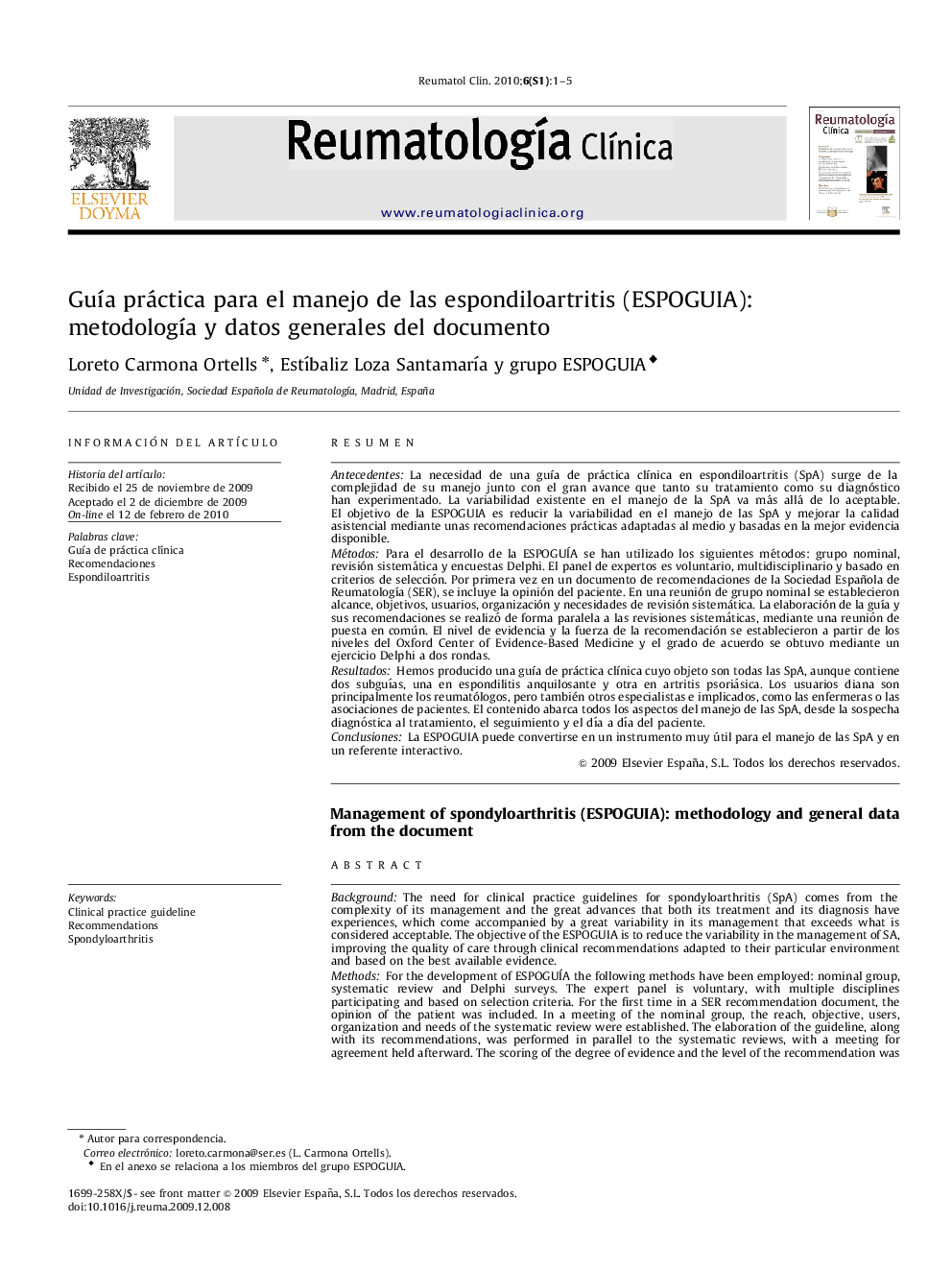| کد مقاله | کد نشریه | سال انتشار | مقاله انگلیسی | نسخه تمام متن |
|---|---|---|---|---|
| 3383636 | 1220472 | 2010 | 5 صفحه PDF | دانلود رایگان |

ResumenAntecedentesLa necesidad de una guía de práctica clínica en espondiloartritis (SpA) surge de la complejidad de su manejo junto con el gran avance que tanto su tratamiento como su diagnóstico han experimentado. La variabilidad existente en el manejo de la SpA va más allá de lo aceptable. El objetivo de la ESPOGUIA es reducir la variabilidad en el manejo de las SpA y mejorar la calidad asistencial mediante unas recomendaciones prácticas adaptadas al medio y basadas en la mejor evidencia disponible.MétodosPara el desarrollo de la ESPOGUÍA se han utilizado los siguientes métodos: grupo nominal, revisión sistemática y encuestas Delphi. El panel de expertos es voluntario, multidisciplinario y basado en criterios de selección. Por primera vez en un documento de recomendaciones de la Sociedad Española de Reumatología (SER), se incluye la opinión del paciente. En una reunión de grupo nominal se establecieron alcance, objetivos, usuarios, organización y necesidades de revisión sistemática. La elaboración de la guía y sus recomendaciones se realizó de forma paralela a las revisiones sistemáticas, mediante una reunión de puesta en común. El nivel de evidencia y la fuerza de la recomendación se establecieron a partir de los niveles del Oxford Center of Evidence-Based Medicine y el grado de acuerdo se obtuvo mediante un ejercicio Delphi a dos rondas.ResultadosHemos producido una guía de práctica clínica cuyo objeto son todas las SpA, aunque contiene dos subguías, una en espondilitis anquilosante y otra en artritis psoriásica. Los usuarios diana son principalmente los reumatólogos, pero también otros especialistas e implicados, como las enfermeras o las asociaciones de pacientes. El contenido abarca todos los aspectos del manejo de las SpA, desde la sospecha diagnóstica al tratamiento, el seguimiento y el día a día del paciente.ConclusionesLa ESPOGUIA puede convertirse en un instrumento muy útil para el manejo de las SpA y en un referente interactivo.
BackgroundThe need for clinical practice guidelines for spondyloarthritis (SpA) comes from the complexity of its management and the great advances that both its treatment and its diagnosis have experiences, which come accompanied by a great variability in its management that exceeds what is considered acceptable. The objective of the ESPOGUIA is to reduce the variability in the management of SA, improving the quality of care through clinical recommendations adapted to their particular environment and based on the best available evidence.MethodsFor the development of ESPOGUÍA the following methods have been employed: nominal group, systematic review and Delphi surveys. The expert panel is voluntary, with multiple disciplines participating and based on selection criteria. For the first time in a SER recommendation document, the opinion of the patient was included. In a meeting of the nominal group, the reach, objective, users, organization and needs of the systematic review were established. The elaboration of the guideline, along with its recommendations, was performed in parallel to the systematic reviews, with a meeting for agreement held afterward. The scoring of the degree of evidence and the level of the recommendation was established from the evidence levels proposed by the Oxford Center of Evidence-Based Medicine and the degree of agreement was obtained through a two-round Delphi exercise.ResultsWe have produced a clinical guideline that encompasses all of the SpA, although it has two sub-guidelines, one for ankylosing spondylitis and the other one for psoriatic arthritis. The target users are mainly rheumatologists, although other specialists and paramedical staff, such as nurses or patient associations, might benefit. Its content envelops all of the management aspects of SpA, from clinical suspicion to treatment, follow-up and day-to-day activities of the patient.ConclusionsESPOGUIA can become a very useful instrument for the management of SA and an interactive reference.
Journal: Reumatología Clínica - Volume 6, Supplement 1, March 2010, Pages 1–5